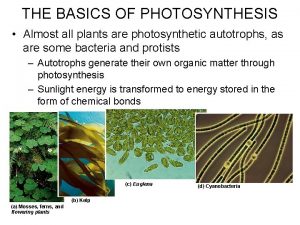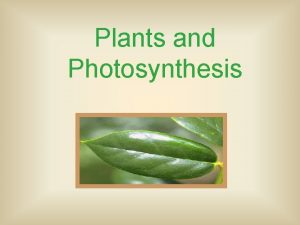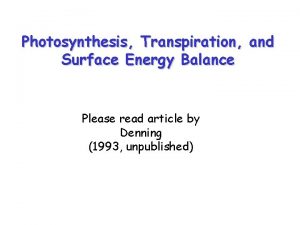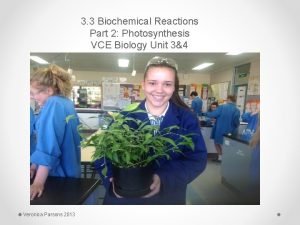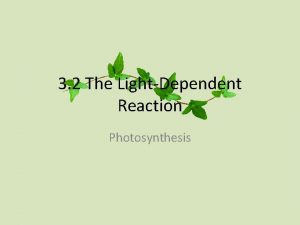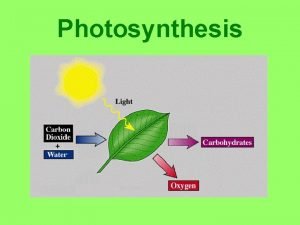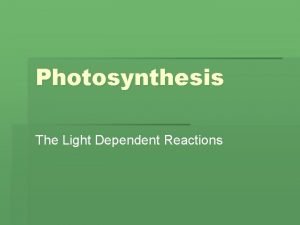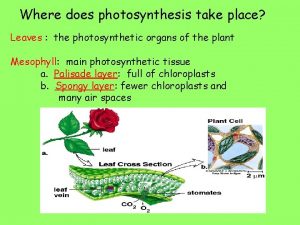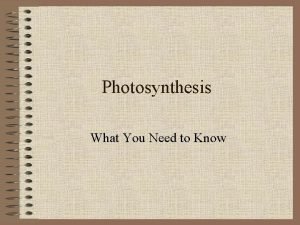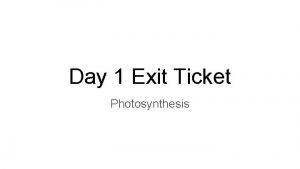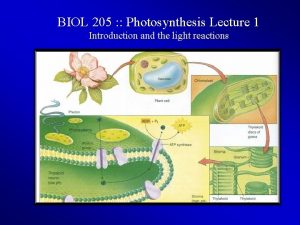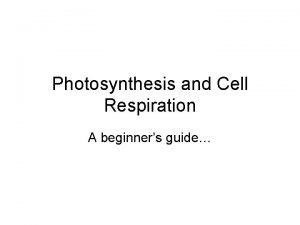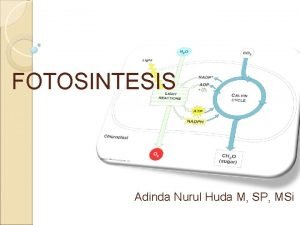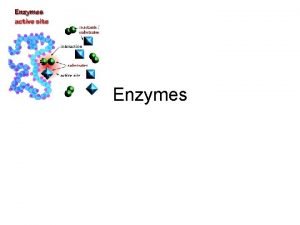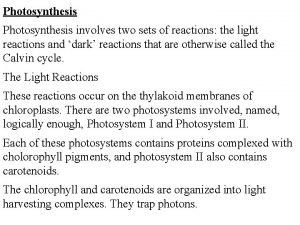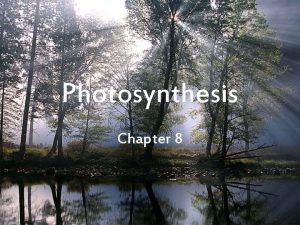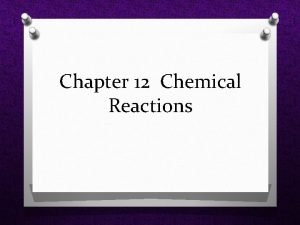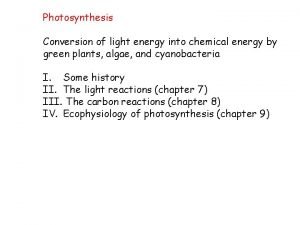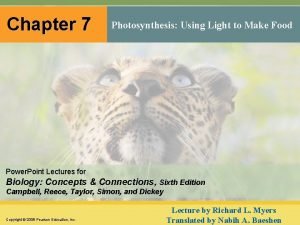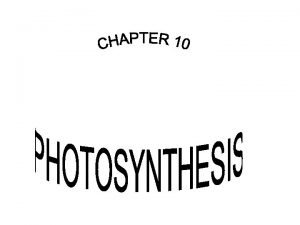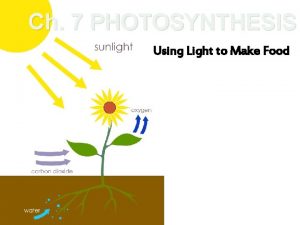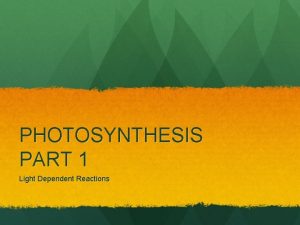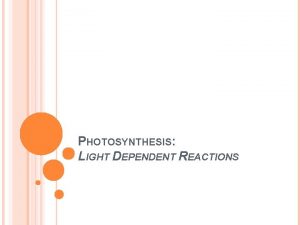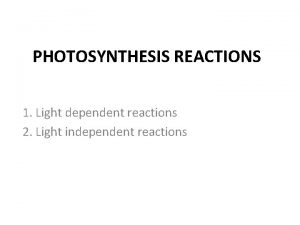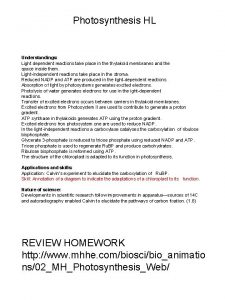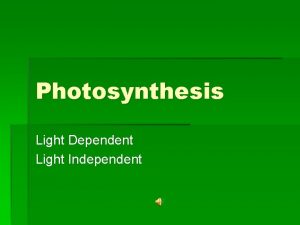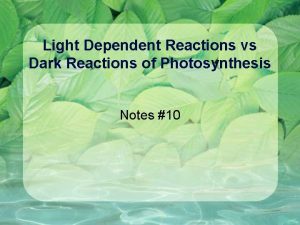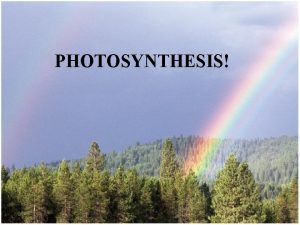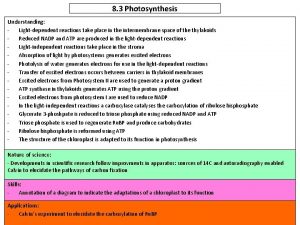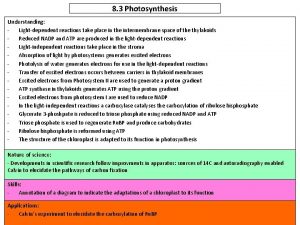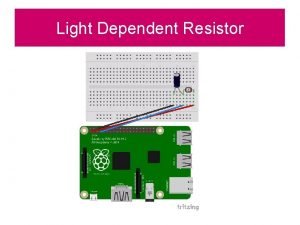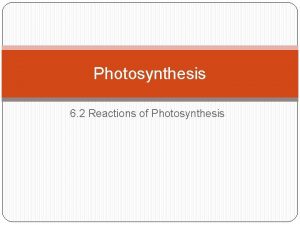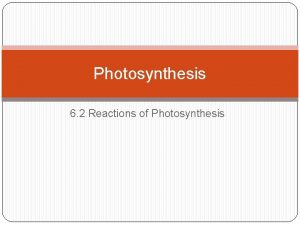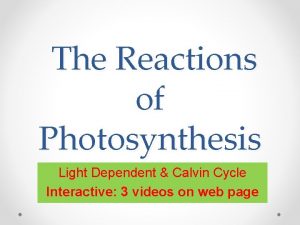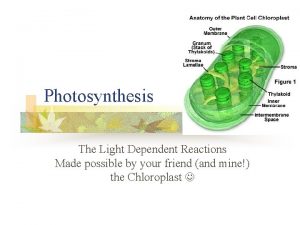Photosynthesis Understanding Light dependent reactions take place in

































- Slides: 33

Photosynthesis

Understanding Light dependent reactions take place in the intermembrane space of the thylakoids Reduced NADP and ATP are produced in the light-dependent reactions Light-independent reactions take place in the stroma Absorption of light by photosystems generates excited electrons Photolysis of water generates electrons for use in the lightdependent reactions Transfer of excited electrons occurs between carriers in thylakoid membranes Excited electrons from photosystem II are used to generate a proton gradient ATP synthase in thylakoids generates ATP using the proton gradient

Understanding (cont. ) Excited electrons from Photosystem I are used to reduce NADP In the light-independent reactions a carboxylase catalyses the carboxylation of ribulose bisphosphate Glycerate 3 -phosphate is reduced to triose phosphate using reduced NADP and ATP Triose phosphate is used to regenerate Ru. BP and produce carbohydrates Ribulose bisphosphate is reformed using ATP The structure of the chloroplast is adapted to its function in photosynthesis

Applications and Skills Application – Calvin’s experiment to elucidate the carboxylation of Ru. BP Skills – Annotation of a diagram to indicate the adaptions of a chloroplast to its function

THE BASICS OF PHOTOSYNTHESIS • Almost all plants are photosynthetic autotrophs, as are some bacteria and protists – Autotrophs generate their own organic matter through photosynthesis – Sunlight energy is transformed to energy stored in the form of chemical bonds (c) Euglena (b) Kelp (a) Mosses, ferns, and flowering plants (d) Cyanobacteria

Light Energy Harvested by Plants & Other Photosynthetic Autotrophs 6 CO 2 + 6 H 2 O + light energy → C 6 H 12 O 6 + 6 O 2

Electromagnetic Spectrum and Visible Light Gamma rays X-rays UV Infrared & Microwaves Visible light Wavelength (nm) Radio waves

WHY ARE PLANTS GREEN? Different wavelengths of visible light are seen by the human eye as different colors. Gamma rays X-rays UV Infrared Visible light Wavelength (nm) Microwaves Radio waves

WHY ARE PLANTS GREEN? Plant Cells have Green Chloroplasts The thylakoid membrane of the chloroplast is impregnated with photosynthetic pigments (i. e. , chlorophylls, carotenoids).

THE COLOR OF LIGHT SEEN IS THE COLOR NOT ABSORBED Chloroplasts absorb light energy and convert it to chemical energy

AN OVERVIEW OF PHOTOSYNTHESIS Photosynthesis is the process by which autotrophic organisms use light energy to make sugar and oxygen gas from carbon dioxide and water Carbon dioxide Water Glucose PHOTOSYNTHESIS Oxygen gas

AN OVERVIEW OF PHOTOSYNTHESIS The light reactions convert solar energy to chemical energy Light Chloroplast Produce ATP & NADPH • The Calvin cycle makes sugar from carbon dioxide – ATP generated by the light reactions provides the energy for sugar synthesis – The NADPH produced by the light reactions provides the electrons for the reduction of carbon dioxide to glucose NADP +P Light reactions Calvin cycle

Chloroplasts: Sites of Photosynthesis • Photosynthesis – Occurs in chloroplasts, organelles in certain plants – All green plant parts have chloroplasts and carry out photosynthesis • The leaves have the most chloroplasts • The green color comes from chlorophyll in the chloroplasts • The pigments absorb light energy

Photosynthesis occurs in chloroplasts In most plants, photosynthesis occurs primarily in the leaves, in the chloroplasts A chloroplast contains: stroma, a fluid grana, stacks of thylakoids The thylakoids contain chlorophyll Chlorophyll is the green pigment that captures light for photosynthesis

The location and structure of chloroplasts Chloroplast LEAF CROSS SECTION MESOPHYLL CELL LEAF Mesophyll CHLOROPLAST Intermembrane space Outer membrane Granum Grana Stroma Inner membrane Stroma Thylakoid compartment

Chloroplast Pigments Chloroplasts contain several pigments – Chlorophyll a – Chlorophyll b – Carotenoids Figure 7. 7

Chlorophyll a & b • Chl a has a methyl group (CH 3) • Chl b has a carbonyl group (COH) Porphyrin ring delocalized e- Phytol tail

Different pigments absorb light differently

Two types of Photon ATP mill Photon photosystems (pigment collections that release electrons when light hits them) cooperate in the light reactions Water-splitting photosystem NADPH-producing photosystem

Noncyclic Photophosphorylation Photosystem II regains electrons by splitting water, leaving O 2 gas as a by-product

Plants produce O 2 gas by splitting H 2 O The O 2 liberated by photosynthesis is made from the oxygen in water (H+ and e-)

The Light Reaction – Key Points When photons are absorbed by P 680 chlorophyll (photosystem II chlorophyll), the excited electrons of P 680 are attracted by the electron acceptor Plastoquinone (PQ). The electrons lost by photosystem II are replaced when a molecule of water is split forming H+ , Oxygen and free electrons. PQ passes electrons on to cytochromes "b 6" and "f" which in turn pass them on to the electron acceptor PC (plastocyanin). As the high energy electrons move from cytochrome b 6 to cytochrome f, they lose potential energy which is coupled to the functioning of a proton pump in the area of these cytochromes. The proton pump takes protons from the stroma and pumps them into the thylakoid spaces within the thylakoid discs. A high concentration of protons builds up inside thylakoid space and these protons then re-enter the stroma through proton re-entry channels by facilitated diffusion. As protons re-enter, there is a release of electrical potential energy which is coupled to the production of ATP from ADP and P. Thus, ATP is

Light Reaction – Key Points As protons re-enter, there is a release of electrical potential energy which is coupled to the production of ATP from ADP and P. Thus, ATP is produced by chemiosmosis. Meanwhile, electrons from photosystem II replace electrons that were lost by photosystem I when light excited them. Those electrons were passed along the chain from ferrodoxin to flavoprotein to NADP reductase The electrons are then taken by NADP+ to form NADPH (reduction) Useful Products: ATP NADPH O 2

Cyclic Photophosphorylation Just One More Thing: Sometimes there isn’t enough NADP to accept the electrons. In this case, ferrodoxin will shuttle the electrons back to PQ and they will go around in a circle. This is useful in that ATP will still be produced. However, NADPH, which is necessary for the formation of glucose, will not be made.

The production of ATP by chemiosmosis in photosynthesis http: //www. youtube. com/watch? v=hj_WKgn. L 6 MI&feature=related

A Photosynthesis Road Map Chloroplast Light Stroma NADP Stack of thylakoids ADP +P Light reactions Calvin cycle Sugar used for Cellular respiration Cellulose Starch Other organic compounds

Calvin Cycle A. k. a. Calvin–Benson-Bassham cycle or C 3 cycle Takes place in the stroma of chloroplasts A cycle of redox reactions that is light independent (dark reactions). This is misleading, however, since it does take place during the day; not in the dark. Used for carbon fixation Calvin cycle consist of 3 phases Carbon Fixation Reduction Reactions Ru. BP Regeneration

Phase 1 - Carbon Fixation This phase defines these plants as C 3 plants due to the primary intermediate produced is a 3 carbon molecule, 3 -phosphoglycerate (PGA) 3 CO 2 combine with 3 Ru. BP (ribulose 1, 5 - biphosphate) to form 3 unstable intermediates that quickly split into 2 three carbon molecules (PGA) each, altogether that is 6 PGA molecules This reaction is catalyzed by rubisco, a large slow enzyme that needs to be in high concentration in order to complete the process efficiently.

Phase 2 - Reduction Reactions The 6 PGA molecules is converted into 6 G 3 P (glyceraldehyde 3 -phosphate). This is done with the aid of 6 ATP and 6 NADPH that provide the necessary amount of electrons One of the G 3 P will move on to create larger sugar molecules for energy storage (glucose, starch). The remaining 5 G 3 P molecules will continue in the calvin cycle to regenerate a sufficient amount of Ru. BP, the first reactant in the calvin cycle.

Phase 3 - Ru. BP Regeneration The 5 remaining G 3 P are rearranged to regenerate 3 Ru. BP using 3 ATP molecules in the process This allows the cycle to continue to fix carbon from CO 2 into energy storing molecules such as glucose The complete process of the calvin cycle: http: //www. science. smith. edu/departments/Biology/ Bio 231/calvin. html

Calvin Cycle Diagram

Review: Photosynthesis uses light energy to make food molecules A summary of the chemical processes of photosynthesis Chloroplast Light Photosystem II Electron transport chains Photosystem I Elec CALVIN CYCLE Stroma tron s Cellular respiration Cellulose Starch LIGHT REACTIONS CALVIN CYCLE Other organic compounds

Photosynthesis Video https: //www. youtube. com/watch? v=w. JDlxp 17 r. Y 4
 Inputs of light reactions in photosynthesis
Inputs of light reactions in photosynthesis Autotrophs self-feeder
Autotrophs self-feeder Light and dark reactions of photosynthesis
Light and dark reactions of photosynthesis Light dependent phase of photosynthesis
Light dependent phase of photosynthesis Light dependent reactions steps
Light dependent reactions steps Sun gives off
Sun gives off Light dependent formula
Light dependent formula Where does photosynthesis take place
Where does photosynthesis take place Where does photosynthesis take place
Where does photosynthesis take place What organelle does photosynthesis take place *
What organelle does photosynthesis take place * How does photosynthesis take place?
How does photosynthesis take place? In which part of the cell does photosynthesis take place
In which part of the cell does photosynthesis take place Fotosintesis
Fotosintesis Will amylase build keratin out of peptides
Will amylase build keratin out of peptides Bacteria double membrane
Bacteria double membrane Light light light chapter 23
Light light light chapter 23 Light light light chapter 22
Light light light chapter 22 Chapter 22
Chapter 22 What are the two sets of reactions for photosynthesis
What are the two sets of reactions for photosynthesis Section 8-1 energy and life
Section 8-1 energy and life Section 8-1 energy and life answers
Section 8-1 energy and life answers Chemical reactions section 2 classifying chemical reactions
Chemical reactions section 2 classifying chemical reactions Reduction half reaction
Reduction half reaction Section 2 reinforcement classifying chemical reactions
Section 2 reinforcement classifying chemical reactions Chemical reactions section 3 reactions in aqueous solutions
Chemical reactions section 3 reactions in aqueous solutions Chemistry unit 5 reactions balancing reactions worksheet
Chemistry unit 5 reactions balancing reactions worksheet Understanding chemical reactions worksheet answer key
Understanding chemical reactions worksheet answer key Photosynthesis glossary
Photosynthesis glossary Learning outcomes of photosynthesis
Learning outcomes of photosynthesis Chemical form of energy
Chemical form of energy Chapter 7 photosynthesis using light to make food
Chapter 7 photosynthesis using light to make food Reaction of photosynthesis
Reaction of photosynthesis Photosynthesis transforms light energy into chemical energy
Photosynthesis transforms light energy into chemical energy Photosynthesis using light to make food
Photosynthesis using light to make food
